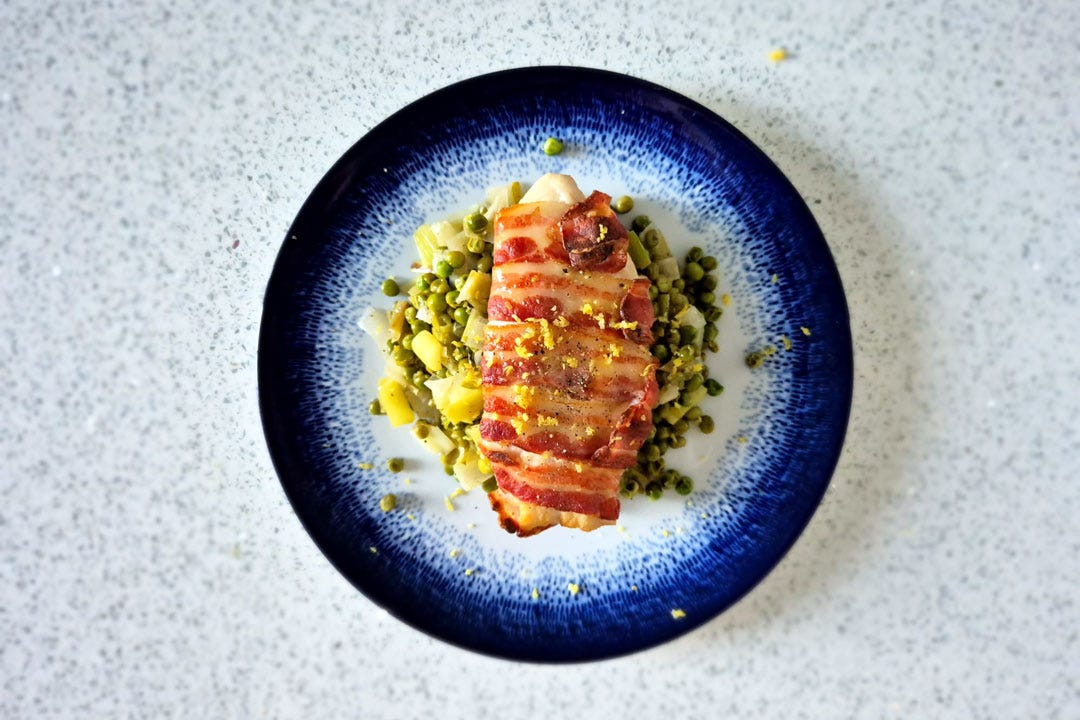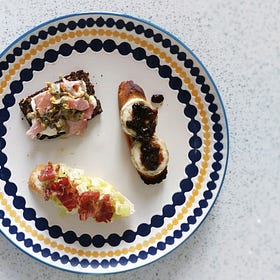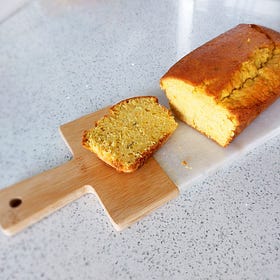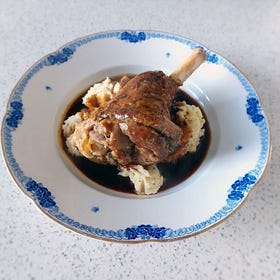The lure of a yellow label
Bacon-wrapped fish with buttered greens recipe
It’s often said that you eventually turn into your parents – and I certainly have characteristics of both Mum and Dad Clarke – but I’ve yet to fully morph into them. I have however, seemingly already turned into my grandparents. My Nannie Gwen’s voice is forever in my head reminding me to ‘sit nicely at the table’, ‘tidy up before you go to bed’ and ‘just have one more for the road’ – perhaps that last one also accounts for my love of sherry. From my Nanna Lena, I learned to make cakes and corned beef pie without really measuring anything, and I always add an extra drop/teaspoon/splash ‘for luck’. From her, I learned the importance of taking photos and the skill of telling stories. But if there’s one thing I’ve inherited from Nanna Lena – via my dad – more than anything else, it’s my love of a bargain.
Nanna and Poppa would shop smart, buying certain products here and others there to get the best value. Nan could also spend an hour in any discount shop inspecting every item to see whether it was worth the pound that they were asking for it. My granddad would wait patiently outside with the shopping bags watching the world go by while nan did her domestic goods inventory. My dad was passed this grocery reductions radar gene, and he will sniff out bargains in everywhere from supermarkets to charity shop. I often benefit from his charity shop finds. And, dear Welsh Kitchen reader, I am proud to say that I am my my grandmother’s grandson and my father’s son.
To clarify, this is not about things being cheap (although being frugal in the current economic situation is not a bad thing), it’s about finding value in the products. For example, I might purchase more expensive clementines because I think they taste better and peel easier. But when I talk about a product’s value, it’s also about how to can get the most out of that product, what I can do or make with it.
I cannot walk past a yellow label – it’s not in my genes to do so. It calls me from the edge of the shelf, luring me in with its flash of sunshine and giant barcode. I have to see what it is. Then I check the mark-down to see if it’s worth a punt on a product I might not normally buy or rejoice that the offer is good on a product I love. I also assess it for how I can use it. I love experimenting in the kitchen, particularly with ingredients that I’ve never used before, and finding a reduced quail or mooli fills me with a culinary creative spark.
My Nannie Gwen also instilled in me a loathing of food waste – eyes bigger than bellies was a cardinal sin and anyone being frivolous with food (think food fights, throwing away perfectly good leftovers) was given short shrift. It’s also for this reason that I can’t leave yellow-labelled goods on the shelf. I hate to think of them being wasted.
I’m trying to clear out my freezer again, as I cannot get any more in it. Nearly everything – bar the garden peas – has a yellow sticker on it. Sea bass fillets, whole chickens, they’re all in there waiting for their moment to shine in my kitchen. Talking of freezers, my flatmates often tell me I should do a series of ‘things I found in my freezer’ and subsequently what I cooked with it. The problem is, I’m not great at labelling leftovers when I freeze them, so it would make for an interesting read (and eating experience). It reminds me of that scene is Victoria Wood’s dinnerladies where Bren says she takes the labels off all her tins, “What’s it going to be? Fruit cocktail? Alphabetti spaghetti?”
Yesterday’s yellow-label haul included a large chicken down from £7 to £4, which I’m cooking for Sunday lunch, and the leftovers of which will go into possibly a pasta or curry. The bones I’ll boil down for stock and then make a soup or spring cawl. I also picked up some reduced oaty baps (reduced from £2.50 to £1.25), one of which I had yesterday for a tuna sarnie, and another this morning for a sausage, egg and brown sauce roll. I might use the other two to make herby croutons for salads or slice them in half and spread with rarebit. I feel like Ainsley Harriott on Ready Steady Cook, never knowing what’s going to be in the bag that I’m going to have rustle something up with. It's exhilarating and makes me be really think about flavours and keeps my meals anything but boring.
So, here’s to the bargain-hunting gene. Thanks Nan!
The Recipe
Bacon-wrapped fish with buttered greens
Cooking fish wrapped in bacon is an old Welsh culinary tradition. Originally, it’s likely that fish was fried simply in bacon fat, but there are several old recipes that use bacon to wrap around the fish – particularly sewin (sea trout). This is likely to have become a more popular way to cook it when ovens became more commonplace in homes. The bacon fat provides moisture to the trout, which can often dry out as it’s easy to overcook. Here in this recipe, I’m using the same principle but have subbed in white fish fillets. It’s an incredibly easy, quick and delicious dinner.
Ingredients (serves 2)
2 chunky white fish fillets (I used Basa – it was in my freezer with a yellow sticker on it – but cod or similar would also work well)
10 rashers of Welsh streaky bacon
2 medium Welsh leeks, roughly chopped
1 tbsp Welsh butter
300g frozen peas
1 lemon
Method
Preheat the oven 200°C/390°F/Gas Mark 6.
Gently wrap the bacon around each of the fish fillets and place on a baking tray lined with a bit of baking parchment, and pop them in the oven. They’ll need about 15-20 mins depending on the fillets, or until otherwise cooked through and with the bacon crisp. Feel free to turn them over half way through.
Meanwhile, soften the leeks in the pan with the butter for about 10 minutes before adding the frozen peas. Add the juice of the lemon, and simmer gently for a further five minutes or so, mixing often until the peas are tender.
Mound up the peas and leeks on a plate and place the fish on top, then grate a little lemon zest all over.
If you try the recipe out, don’t forget to tag any photos with #mywelshkitchen.
The Playlist
To me, cooking and music go hand in hand, whether that’s singing at the top of your voice using a wooden spoon as a microphone while waiting for pasta to boil, or dancing around with the oven gloves on as the oven timer counts down. Here are some ideas for your Welsh Kitchen playlist.
The very first Eurovision Song Contest was held 69 years ago yesterday on 24 May 1956. So, with that in mind, here are just a few UK Eurovision entrants with a Welsh connection. There are more, but here’s my selection.
1970 – Knock, Knock Who's There? by Pontardawe-born Mary Hopkin
1976 – Save Your Kisses for Me by Brotherhood of Man (member Nicky Stevens was born in Carmarthen)
1990 – Give a Little Love Back to the World by Emma (Louise Booth) from Bridgend
1992 – One Step Out of Time by Micheal Ball, whose mum is Welsh, and considers himself Welsh
2002 – Come Back by Jessica Garlick who grew up in Kidwelly
2017 – Never Give up On You by Pentyrch-born Lucie Jones
From the archive
Home and away
It's been a month of travel for me. April and May are always busy months for travel writers, as hotels and travel companies want to get you in to see their new offerings before the high season starts. I'm not complaining. I love exploring a new place or rediscovering an old favourite through its food scene. We can learn so much from other cultures and t…
Time for a twmpath
May has always been a time for celebration in Wales. It marks the moment that farmers would move their flocks up onto the mountains from the valley floor, and move to the hafod – the summer dwelling (haf means summer in Welsh) – from the hendre – the winter dwelling (
Low and slow
There is some meat that you have to cook quickly: a minute steak for example, or a rack of lamb perhaps, but on the whole, meat – particularly red meat should take its time to cook. I’m a firm believer in the low and slow method of cooking . It gives the fat time to melt properly to keep everything tender and rich, allows you to buy cheaper, less-prized (although not in my kitchen) cuts, and gives you time to do other stuff while it’s doing its merry thing in the oven or slow cooker.





